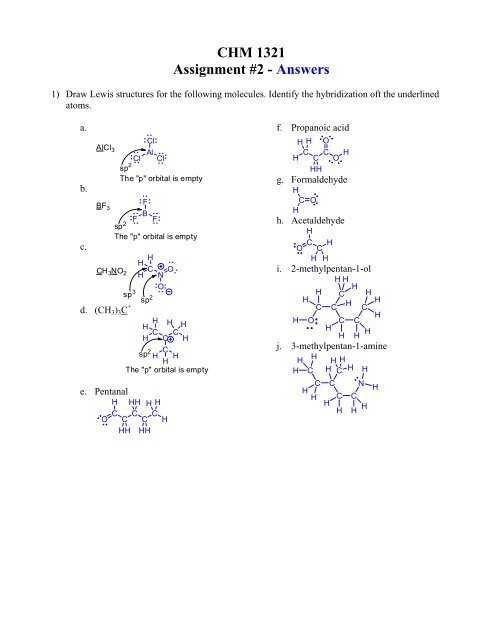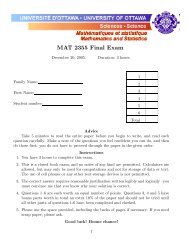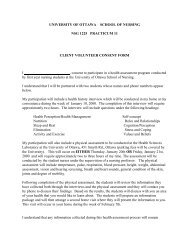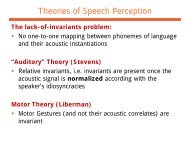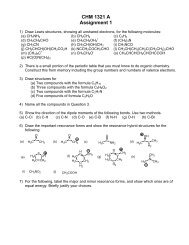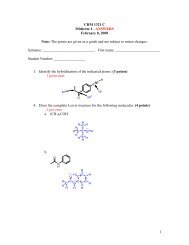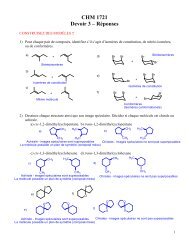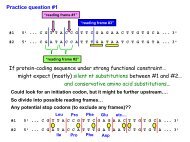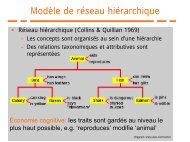CHM 1321 Assignment #2 - Answers - Université d'Ottawa
CHM 1321 Assignment #2 - Answers - Université d'Ottawa
CHM 1321 Assignment #2 - Answers - Université d'Ottawa
Create successful ePaper yourself
Turn your PDF publications into a flip-book with our unique Google optimized e-Paper software.
<strong>CHM</strong> <strong>1321</strong><br />
<strong>Assignment</strong> <strong>#2</strong> - <strong>Answers</strong><br />
1) Draw Lewis structures for the following molecules. Identify the hybridization oft the underlined<br />
atoms.<br />
a.<br />
b.<br />
c.<br />
Cl<br />
AlCl 3<br />
Al<br />
Cl Cl<br />
sp 2<br />
The "p" orbital is empty<br />
BF<br />
F<br />
3<br />
F B F<br />
sp 2<br />
The "p" orbital is empty<br />
H<br />
H<br />
CH<br />
H C 3 NO 2<br />
O<br />
N<br />
O<br />
sp 3 sp 2<br />
d. (CH 3 ) 3 C + H H<br />
H<br />
C C<br />
H<br />
H<br />
C H<br />
C<br />
sp 2<br />
H H<br />
H<br />
The "p" orbital is empty<br />
e. Pentanal<br />
H HH H H<br />
C C C<br />
O C C H<br />
HH HH<br />
f. Propanoic acid<br />
H H O<br />
C C<br />
H C O H<br />
HH<br />
g. Formaldehyde<br />
H<br />
C O<br />
H<br />
h. Acetaldehyde<br />
H<br />
C H O C<br />
H H<br />
i. 2-methylpentan-1-ol<br />
H H<br />
H<br />
H C H<br />
H<br />
C C<br />
H H<br />
C<br />
H<br />
H O C C<br />
H H H H<br />
j. 3-methylpentan-1-amine<br />
H<br />
H H H<br />
H C H C H H<br />
C C N<br />
H<br />
H<br />
H C C<br />
H<br />
H H H
<strong>Assignment</strong> 2 - <strong>Answers</strong><br />
2) Each structure below is missing a charge—assign formal charges to show which atom bears the<br />
charge.<br />
a.<br />
H<br />
H 3 C OH 2<br />
O<br />
H 3 C<br />
H<br />
b.<br />
c.<br />
H 3 C NH 3<br />
FC (oxygen) = 6-3-2 = +1<br />
H H<br />
H 3 C N H<br />
FC (nitrogen) = 5-4-0 = +1<br />
d.<br />
H 3 C NH 2<br />
OH<br />
H 3 C N H<br />
FC (nitrogen) = 5-2-4 = -1<br />
O H<br />
e.<br />
f.<br />
H 3 C C CH 3<br />
O<br />
H 3 C C CH 2<br />
H 3 C C CH 3<br />
FC (oxygen) = 6-3-2 = +1<br />
O<br />
H 3 C C<br />
C<br />
H<br />
H<br />
FC (carbon) = 4-3-2 = -1<br />
H<br />
C C<br />
H<br />
C C<br />
FC (carbon) = 4-3-2 = -1<br />
g.<br />
O<br />
H 3 C C CH 2<br />
O<br />
H 3 C C CH 2<br />
FC (oxygen) = 6-1-6 = -1<br />
2
3)<br />
a. Convert each of the following molecules to a line structure<br />
b. Name each compound<br />
i.<br />
H 3 C CH2<br />
H 2<br />
C CH2<br />
CH 3<br />
pentane<br />
<strong>Assignment</strong> 2 - <strong>Answers</strong><br />
ii.<br />
iii.<br />
O<br />
H 3 C C O<br />
CH 3<br />
2-butanone<br />
C<br />
H2<br />
H 2 C<br />
H 2<br />
C H CH 3<br />
C<br />
1-methylcyclohexanone<br />
H 2 C CH2<br />
CH 2<br />
iv.<br />
CH<br />
H 3<br />
2<br />
C H CH<br />
H 2 C C CH3<br />
H 2 C CH 2 CH2<br />
isopropylcyclohexanone<br />
OR<br />
1-(1-methylethyl)cyclohexane<br />
NOTE: Don’t forget to include the “cyclo” when naming cyclic molecules!<br />
4) Diethyl ether and 1-butanol have similar solubilities in water, but their boiling points are very<br />
different. Explain why these compounds have similar solubility properties but different boiling points.<br />
O<br />
solubility 8.4 mL in 100 mL H 2 O<br />
bp 35 o C<br />
OH<br />
solubility 8.9 mL in 100 mL H 2 O<br />
bp 118 o C<br />
Each molecule has about the same amount of Van der Waals interactions, and the Van der Waals surfaces<br />
are relatively large. Each compound has a dipole, lone pairs on oxygen and is able to hydrogen bond with<br />
water. Therefore each compound has similar solubility in water.<br />
The hydrogen bonds in butanol are stronger that the dipole interactions in diethyl ether. Butanol has a<br />
higher boiling point because of the stronger hydrogen bonds. The intermolecular forces holding the<br />
butanol molecules together are stronger than those holding the diethyl ether molecules together.<br />
5) Explain the difference in boiling point for the following pairs of compounds:<br />
a)<br />
CH 3<br />
N<br />
bp 81 o C<br />
and<br />
H<br />
N<br />
bp 106 o C<br />
Each molecule has about the same Van der Waals ability. N-methyl-pyrrolidine (on the left) is capable of<br />
dipole-dipole interactions. Piperidine (on the right) has a dipole and can also hydrogen bond with itself<br />
(lone pair of electrons and hydrogen on the nitrogen atom). Therefore Piperidine has the higher boiling<br />
point.<br />
Note: The nitrogen of N-methyl-pyrrolidine has a lone pair and can hydrogen bond with water (water<br />
donates the hydrogen and is called a hydrogen bond donor). N-methyl-pyrrolidine donates the lone pair<br />
3
<strong>Assignment</strong> 2 - <strong>Answers</strong><br />
and is called a hydrogen bond acceptor. N-methyl-pyrrolidine cannot hydrogen bond with itself because<br />
there are no hydrogens on polar heteroatoms (N) in this structure.<br />
OH<br />
b)<br />
bp 141 o C<br />
and<br />
O<br />
bp 88 o C<br />
Each molecule has about the same Van der Waals ability. Both molecules have dipoles. Cyclopentanol (on<br />
the left) is capable of hydrogen bonding with itself. Tetrahydropyran (on the right) is only capable of<br />
dipole-dipole interactions. Therefore cyclopentanol has the higher boiling point since hydrogen bonds are<br />
stronger than dipole interactions.<br />
6) Which of the following compounds can form hydrogen bonds Which can form hydrogen bonds with<br />
water<br />
H<br />
a)<br />
N<br />
b)<br />
N<br />
c)<br />
d)<br />
O<br />
e) f)<br />
O<br />
O<br />
g) NH 2<br />
O<br />
Compounds (a) and (g) can form hydrogen bonds between their own molecules. Each of these has<br />
hydrogens capable of hydrogen bonding (H’s on nitrogen) and heteroatoms with lone pairs (N in structure<br />
(a); N and especially O in structure (g).<br />
Compounds (a) and (g) can of course form H bonds with water. Compounds (b), (d) and (f) can form<br />
weaker hydrogen bonds with water. They have no hydrogens available, but do have lone pairs that can<br />
form hydrogen bonds with water.<br />
7) Predict which of the following pairs of compounds will have the higher boiling point and explain your<br />
prediction.<br />
a) O or<br />
OH<br />
Both have dipoles, however the second structure is capable of<br />
hydrogen bonding with itself (H and lone pairs on oxygen). These<br />
molecules held together by hydrogen boonds<br />
b)<br />
or<br />
Most Van der Waals forces because of larger<br />
molecules<br />
c) or<br />
Most Van der Waals forces due to least amount of branching<br />
(largest contact area)<br />
d)<br />
or<br />
Cl<br />
Dipole-Dipole interactions, cyclohexane has Van der Waals<br />
forces only. Dipole-Dipole interactions are stronger than Van<br />
der Waals forces.<br />
4
8) Provide names for the following compounds<br />
a)<br />
2-Methylpentane<br />
<strong>Assignment</strong> 2 - <strong>Answers</strong><br />
b)<br />
3-Ethyl-2-methyloctane<br />
c)<br />
2,6-Dimethyloctane<br />
d)<br />
4-methyl-5-isopropylnonane<br />
or<br />
4-Methyl-5-(1-methylethyl)nonane<br />
e)<br />
1,3-Dimethylcyclohexane<br />
9) Which of the following represent different compounds Which represent the same compound<br />
(molecules that are the same in each part are grouped with similar shaped and colored boxes)<br />
same<br />
a)<br />
H H<br />
H C C<br />
H H<br />
H<br />
C H<br />
CH 3<br />
H H<br />
H C C<br />
H H<br />
H<br />
C<br />
H<br />
H<br />
C<br />
H<br />
H<br />
H H<br />
H C C<br />
H H<br />
CH 3<br />
C H<br />
CH 3<br />
same<br />
b)<br />
same<br />
same<br />
c)<br />
same<br />
same<br />
cis 1, 3-dimethylcyclohexane<br />
trans-1, 3-dimethylcyclohexane<br />
same<br />
d)<br />
H H H CH 3<br />
H H<br />
H C C C C H 3-ethylpentane H C C<br />
H H H CH 3<br />
H<br />
CH 3<br />
CH 3<br />
C H<br />
CH 3<br />
same<br />
5
<strong>Assignment</strong> 2 - <strong>Answers</strong><br />
10) Predict which of the following in each set of compounds will have the highest water solubility. Which<br />
will have the lowest Explain your answers.<br />
a)<br />
HO<br />
HO<br />
O<br />
OH<br />
CH 3<br />
OH<br />
highest water solubility<br />
most hydrogen bonds possible<br />
HO<br />
H 3 C<br />
O<br />
CH 3<br />
CH 3<br />
OH<br />
H 3 C<br />
O<br />
CH 3<br />
H 3 C OH<br />
CH 3<br />
lowest water solubility<br />
fewest hydrogen bonds possible<br />
b)<br />
O<br />
O<br />
MeO<br />
MeO<br />
HO<br />
O<br />
O<br />
lowest water solubility<br />
highest water solubility<br />
fewest hydrogen bonds possible<br />
charged species have very strong<br />
dipole interactions (ionic). This makes<br />
for strong interactions with water.<br />
c)<br />
O<br />
O<br />
O<br />
NH<br />
O<br />
OH<br />
highest water solubility<br />
most hydrogen bonds possible<br />
lowest water solubility<br />
no hydrogen bonds possible<br />
11) Use a Newman projection, about the indicated bond, to draw the most stable conformer for each<br />
compound. What is the least stable conformer of each<br />
Only one set of answers are shown. There are many ways to draw a Newman projection. It does not matter<br />
which side of the bond you draw the projection from. The angle of the front carbon on the paper does not<br />
matter. What is important is whether groups are eclipsed or staggered, the attachment of substituents to the<br />
bond in question, and the proper angles between substituents on a given carbon. If you are unsure, check<br />
with your TA or Prof.<br />
6
a)<br />
3-methylpentane about the C2-C3 bond.<br />
2<br />
<strong>Assignment</strong> 2 - <strong>Answers</strong><br />
3<br />
Newman projections C2 in front<br />
CH 3 CH 3<br />
H CH 2 CH 3 H 3 C H<br />
H H<br />
H H<br />
CH 3<br />
CH 2 CH 3<br />
Newman projections C2 in back<br />
CH 3 CH 2 CH 3<br />
H H<br />
H H<br />
H CH<br />
CH 2 CH 3 H 3 C H<br />
3<br />
CH 3<br />
Best conformers (Anti Staggered)<br />
(Energies similar,<br />
but slight preference for ethyl in anti position)<br />
H 3 CCH 3<br />
H<br />
H H<br />
CH 2 CH 3<br />
CH 3 CH 2 H 3 C CH 2 CH 3<br />
CH 3<br />
H<br />
CH 3<br />
H 3 C H<br />
H H<br />
H<br />
H<br />
Worst conformers (Alkyl groups eclipsed)<br />
(Energies similar)<br />
H 3 C CH 3<br />
H<br />
H CH<br />
H 2 CH 3<br />
b)<br />
3, 3-dimethyl hexane about the C3-C4 bond<br />
2<br />
3<br />
4<br />
Best conformers (Anti Staggered)<br />
(Energies similar)<br />
Newman projections C3 in front<br />
Newman projections C3 in back<br />
CH 2 CH 3<br />
CH 2 CH 3<br />
H<br />
CH 2 CH 3<br />
H CH 2 CH 3 H H<br />
H 3 C CH 3<br />
H 3 C CH 3<br />
H 3 C CH<br />
H 3 H 3 C CH 3<br />
H CH 2 CH 3<br />
H H<br />
CH 2 CH 3<br />
CH 2 CH 3<br />
CH 2 CH 3<br />
CH 2 CH 3<br />
H<br />
H 3 CH 2 C H<br />
H 3 C CH 3<br />
H 3 C CH<br />
H 3<br />
H 3 CH 2 C H<br />
CH 2 CH 3<br />
Worst conformers (Alkyl groups eclipsed)<br />
(Energies similar)<br />
HCH 2 CH 3 HCH 2 CH 3<br />
H<br />
CH<br />
H 3 C CH 2 CH 3<br />
3 H 3 C CH 3<br />
H 3 CH 2 C<br />
H<br />
H 3 CH 2 C<br />
CH 2 CH 3<br />
H<br />
H 3 C CH 3<br />
H<br />
H 3 C CH 2 CH 3 H 3 C CH 2 CH 3<br />
CH 2 CH 3 CH<br />
H H<br />
3<br />
H H<br />
H 3 C H 3 CH 2 C<br />
H 3 CH 2 C CH 2 CH 3<br />
CH 3<br />
H H<br />
H 3 C<br />
7
c) bromobutane about the C1-C2 bond<br />
<strong>Assignment</strong> 2 - <strong>Answers</strong><br />
1<br />
Br<br />
2<br />
Newman projections C1 in front<br />
Newman projections C1 in back<br />
Br<br />
CH 2 CH 3<br />
H H<br />
H H<br />
H H<br />
Best conformer (Anti Staggered)<br />
H H<br />
CH 2 CH 3<br />
Br<br />
H 3 CH 2 CBr<br />
H<br />
H<br />
H<br />
H<br />
Worst conformer (large groups eclipsed)<br />
Br CH 2 CH 3<br />
H<br />
H H<br />
H<br />
d)<br />
H<br />
H<br />
CH 2 CH 3<br />
H<br />
H<br />
CH 2 CH 3<br />
Best conformer (Anti Staggered)<br />
H 3 CH 2 CCH 2 CH 3<br />
H<br />
H<br />
H<br />
H<br />
Worst conformer (large groups eclipsed)<br />
e)<br />
H<br />
H<br />
H<br />
H<br />
H<br />
H<br />
H<br />
H<br />
H<br />
H<br />
H<br />
H<br />
H<br />
H<br />
H<br />
H<br />
Best conformers (Staggered)<br />
Chairs<br />
H<br />
H<br />
H<br />
H<br />
H<br />
H<br />
H<br />
H<br />
H<br />
H<br />
HH<br />
HH<br />
H<br />
H<br />
Worst conformer (eclipsed)<br />
(Boat, view is of bond shown)<br />
8
12) Consider cis-1,3-dimethylcyclohexane.<br />
a) Draw the two chair conformations using line notation.<br />
1<br />
CH 3<br />
<strong>Assignment</strong> 2 - <strong>Answers</strong><br />
3<br />
CH 3<br />
CH 3<br />
CH 3<br />
1<br />
H 3 C CH 3<br />
3 3 1<br />
b) Re-draw the two chair conformations showing all the axial hydrogens.<br />
H CH 3<br />
CH H 3 H H<br />
H 3 C CH 3<br />
H<br />
H H<br />
H H<br />
H<br />
c) Re-draw the two chair conformations showing all the equatorial hydrogens.<br />
CH 3<br />
CH<br />
H 3<br />
H<br />
H H H H H H<br />
H3 C<br />
CH 3<br />
H<br />
H<br />
d) Label the high and low energy conformers in part a<br />
CH 3<br />
CH 3<br />
H3 C<br />
CH 3<br />
High Energy<br />
(Both Me's axial)<br />
Low Energy<br />
(Both Me's equatorial)<br />
note: Me = CH 3<br />
9
13) Repeat question 9 for trans-1,2-dimethylcyclohexane.<br />
CH 3<br />
1<br />
2<br />
CH 3<br />
<strong>Assignment</strong> 2 - <strong>Answers</strong><br />
CH 3<br />
1<br />
1 CH<br />
2 2<br />
3<br />
CH<br />
CH 3<br />
3<br />
Axial H's<br />
H<br />
H<br />
H<br />
H<br />
H<br />
CH 3<br />
CH 3<br />
H<br />
H<br />
H CH 3<br />
CH 3 H<br />
H<br />
Equatorial H's<br />
H H<br />
H<br />
3 CH<br />
H<br />
H<br />
H H H<br />
H<br />
H<br />
CH 3<br />
CH 3<br />
CH 3<br />
High Energy<br />
(Both Me's axial)<br />
Low Energy<br />
(Both Me's equatorial)<br />
14) Draw the two chair conformations of each compound listed below. For each structure, label the<br />
substituents (groups other than hydrogen) as being axial and equatorial.<br />
a) cis-1-ethyl-2-isopropylcyclohexane<br />
2<br />
1<br />
axial<br />
b) trans-1-ethyl-3-methylcyclohexane<br />
equatorial<br />
axial<br />
equatorial<br />
3<br />
1<br />
axial<br />
3<br />
equatorial<br />
1<br />
3<br />
axial<br />
1<br />
equatorial<br />
10
c) cis-1-ethyl-4-methylcyclohexane<br />
<strong>Assignment</strong> 2 - <strong>Answers</strong><br />
4<br />
1<br />
equatorial<br />
15) Draw the most stable form of glucose.<br />
O<br />
HO<br />
4<br />
HO<br />
OH<br />
axial<br />
1<br />
OH<br />
OH<br />
axial<br />
4<br />
equatorial<br />
1<br />
HO<br />
O<br />
HO<br />
HO<br />
HO OH<br />
most groups equatorial<br />
16) Draw the Newman projection of methylcyclohexane about the C1-C2 bond for the most stable and<br />
least stable chair conformers. Clearly identify which is which, and briefly justify your choice.<br />
(Bonds in Newman projection are shown in red on the chairs. Note that these are the same bonds in each<br />
structure)<br />
H<br />
H<br />
H<br />
H<br />
H<br />
H<br />
CH 3<br />
H<br />
Most stable<br />
CH 3 equatorial<br />
H<br />
H<br />
H<br />
H<br />
H<br />
CH 3<br />
H<br />
H<br />
Least stable<br />
CH 3 axial<br />
17) Draw the Newman projections of the two chair conformations of trans-1, 3-dibromocyclohexane (hint<br />
check out figure 4-6). Identify the most and least stable conformers (if any).<br />
Br<br />
Br<br />
Br<br />
Br<br />
Br<br />
Br<br />
H<br />
H H<br />
Br<br />
H<br />
H<br />
H<br />
Br H<br />
H<br />
Br<br />
H<br />
Chairs equal energy - each has 1 equatorial and 1 axial bromine<br />
Br<br />
H<br />
H<br />
H<br />
Note: heavy bonds are shown in projections above<br />
11


